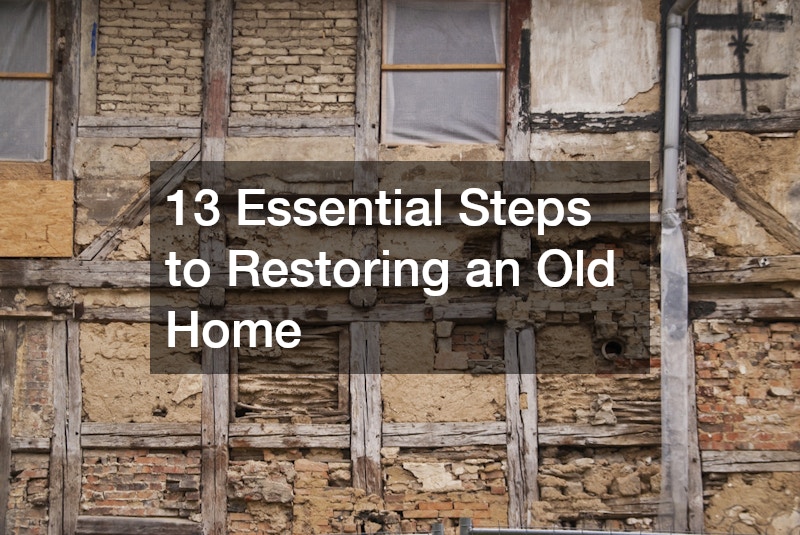Fixing up an older home can be a rewarding experience. Older houses have a charm and character, which is often hidden under layers of worn-out systems and architectural quirks. You can bring an old house back to its former glory, or even better, with the right planning, patience and professional guidance. This will add value and comfort while adding value. It’s not always easy to navigate the journey. Each step, from assessing structural integrity to upgrading mechanical systems and renovating kitchens, bathrooms and curb appeal, requires careful consideration and attention to detail.
Be aware that older houses have a story to tell. The older homes were constructed in a previous era and often used different materials and methods. It’s fun to discover what makes your home unique while also updating it to meet modern standards. Remember that you do not have to tackle these tasks alone. You can save time, money and frustration by relying on the expertise of professionals—for example, a plumber for your pipes or a door installer to update entryways. The goal is to give room for a new life while maintaining the original soul.
Follow these 13 steps to transform your old house. Don’t hesitate to ask for help and adjust the process if necessary. These steps can help you make sure that your home investment will pay dividends for comfort, enjoyment and value, whether you plan to live in it for decades or sell it in the future.
Step 1: Assess the Home’s Structural Integrity
Assess the structural integrity and age of your home. Older homes may have settling foundations or rotting beams. They might also use outdated materials and building materials which do not meet the current codes. Ask a professional engineer or an expert from a reputable construction company to examine the property. They can identify potential problems that could compromise your renovation plans. This evaluation forms the foundation—literally and figuratively—of the entire project. Even the best renovations will not last if the structure isn’t solid and stable.
Attention should be paid to the load-bearing wall, the floor joists and the original workmanship. Older homes may have unique features and quirks, even though they might be built with modern engineered wood and adhere to predictable building codes. A major structural issue caught early can prevent a lot of headaches and costs in the future.
Step 2: Repair the Roof and Gutters

Roofs are one of the most important components in an older home. The roof protects your property from the weather and is a major contributor to energy efficiency. Calling roofing companies to inspect the roof and possibly replace it is a good idea if you notice that your roof appears worn, sagging or has missing shingles. Maintaining your roof will not only protect your investment, but it will also give you peace of mind knowing that your house is weather-tight.
Don’t forget the gutters when you are working on your roof. Water damage can cause havoc to an old home’s wooden frame and masonry. Hire a seamless installer to make sure you have proper drainage. Seamless gutters can reduce the chance of leaking at the joints. The addition of gutter protection can enhance the system’s longevity and functionality. A reputable gutter protection company can assist you in selecting and installing guards that prevent debris from entering your gutters and allow water to flow freely. This will protect the foundation of your home and prevent costly damage.
Step 3: Resolve Foundation and Basement Problems
Over time, foundations can settle in older homes, causing cracks and uneven flooring. Address any issues that you may notice as soon as possible, such as dampness or mustiness in the basement or water seepage. Moisture problems can cause mould, mildew, and structural damage. The basement can be kept dry and stable by sealing the foundation, improving drainage, adding sump pumps, or installing interior French drains.
If the project seems too complicated, you may want to consider professional help. Some companies specialising in house construction can offer advice on waterproofing and stabilising your basement. If you plan to do major renovations on the lower floors, such as turning your basement into a living area, investing in a solid foundation that is dry and strong is essential.
Step 4: Replace Windows and Exterior Doors
The insulation of old windows and doors is often inadequate, resulting in drafts, high energy costs, and uneven indoor temperatures. Modern energy-efficient windows will improve your comfort and help you save money. Double or triple-paned windows with low-E coatings are ideal. These upgrades can help you maintain a constant indoor climate and increase the value of your home.
It’s possible that your old entrances are charming, but they’re not secure or weather-tight. Modern doors can be installed by a skilled installer. They provide improved insulation, enhanced security, and a style that compliments your home’s architectural design. Don’t be afraid to invest in quality windows and doors. This step will benefit you long-term by enhancing your home’s beauty and functionality.
Step 5: Update Plumbing and Electrical Systems
Many older homes have outdated electrical and plumbing systems, which may not meet current safety standards. Faulty wiring, corroded pipe, and reduced efficiency can all be hazards. They also complicate renovations. By hiring a plumbing company that is qualified to evaluate and upgrade old pipes, you can avoid persistent leaks and poor water pressure in the future. Modern plumbing allows you to install high-quality fixtures with water-saving features.
The old knob-and-tube wiring and outdated fuse boxes can also be replaced by modern electrical panels that are compatible with today’s appliances. Professionals are required to upgrade electrical systems. They ensure that the system is up to local code, can handle higher load demands and reduces fire risks. These updates will allow you to upgrade your appliances and technology in the future.
Step 6: Renovate the Kitchen
In many homes, the kitchen is at its heart. However, older properties may have outdated cabinets, worn-out countertops, or inefficient layouts. Kitchen renovations that are well-planned can improve your home’s value and make it more appealing to potential buyers. Remodelling contractors with experience in older homes can provide updates that combine modern conveniences with classic charm.
Focus on function: make sure you have enough counter space, use smart storage solutions and choose surfaces that are easy to clean. The kitchen will be more functional and valuable if you choose appliances that are in line with the design and size of your home. Do not forget to pay attention to the little details like lighting and ventilation. Kitchen renovations are a great way to improve comfort, aesthetics and efficiency in an area that everyone gravitates towards.
Step 7: Modernise the Bathrooms

The bathrooms in older homes may feel cramped and dated. The overall appeal of a home can be affected by outdated fixtures, worn-out finishes and bad layouts. Modernising bathrooms not only makes them more comfortable to use but also increases the value of the home. It’s a good idea to partner with bathroom remodelers that specialise in older homes. They know how to combine contemporary features, such as walk-in-showers, efficient toilets and double vanities, with traditional details.
Choose materials that can withstand moisture. A bathroom can be transformed into a spa-like oasis with tile, stone and paint that resists moisture. Upgraded plumbing fixtures, along with proper ventilation, will ensure that your bathroom remains mold-free and clean for many years.
Step 8: Upgrade the HVAC System
The climate control system is essential for comfort and efficiency, particularly in older homes built before central heating or cooling was common. If you have an existing HVAC system, consider upgrading it to a more modern model. Central air or ductless systems can be installed if the home relies heavily on window air conditioners or old radiators.
Improved insulation and sealing gaps around doors, windows, and the attic can be combined with HVAC upgrades. Your HVAC system will run more efficiently when it doesn’t need to battle against drafts and poor insulation. This saves you money while maintaining a comfortable indoor climate. Add programmable thermostats and smart home features to fine-tune the climate control.
Step 9: Refresh Exterior Finishes and Siding
Peeling paint, cracked siding or weathered finishes can reveal the age of an older home. The restoration of the facade will not only improve curb appeal, but it will also protect the structure underneath from the elements. Local house painters with experience in historic properties can be hired. They will know how to properly prepare surfaces, select paints that suit the style of the home, and finish using techniques that last.
Consider updating your siding to materials that combine aesthetics with durability and insulation. The look and performance of your home can be dramatically improved by using fibre cement, engineered wooden siding, or restored original wood. The exterior is the first thing guests and prospective buyers see. The exterior of the house should be well maintained.
Step 10: Refinish Floors and Walls
The interior of the house can be revealed by worn-out flooring and cracked walls. If you have hardwood floors, they can be refinished and restored to their original beauty. Modern hardwood, laminate or tile flooring can be a great option if your existing flooring cannot be repaired or is damaged beyond repair. Do not rush through this step. Quality flooring sets the tone of the entire interior.
The walls may require patching, smoothing and repainting. A fresh coat of paint, whether you use neutral colors or those that reflect your home’s age, can make the space feel brighter and more inviting. Some homeowners choose to leave the original brick exposed or install wainscoting in order to keep a historic feel. It’s important to create a cohesive and welcoming interior that reflects the character of your home while still meeting modern standards.
Step 11: Insulate for Energy Efficiency
Many older homes lack insulation which can lead to drafty rooms, high energy bills and drafty walls. Insulating walls, crawl spaces, attics and even walls can help to stabilise the temperature in your home and improve comfort. Seal air leaks around electrical outlets, doors, windows and attics.
It is not only possible to save energy, but it also makes the house more peaceful. It’s much easier to install insulation when walls are still open if you plan a major renovation. Consult professionals who are familiar with the challenges associated with insulating older homes. They can suggest the best materials and techniques to ensure the home is energy efficient without losing its charm.
Step 12: Boost Curb Appeal and Landscaping
After you have completed all the structural, mechanical and interior upgrades, focus on curb appeal. If you are planning to live in your home for a long time or list it on the real estate market, a well-maintained exterior and welcoming landscape will set your house apart. Simple improvements like adding flowerbeds, planting shrubs and trimming overgrown trees can completely transform your yard. Consider adding a walkway with a stylish design and outdoor lighting that highlights architectural details.
Do not forget to add the little touches. A restored porch, beautiful house numbers or a charming mailbox can give your home a warm and welcoming feeling. It’s not just about the aesthetics. Improving curb charm also speaks volumes about how much care you have put into your home. Visitors and potential buyers will both appreciate a well-maintained home.
Step 13: Plan for Maintenance and ROI
Take a moment to reflect on what you have accomplished. Each renovation—whether hiring remodelling contractors to overhaul the kitchen, engaging a door installer to secure the entryways, or calling on a gutter guard company to protect the foundation—contributes to the home’s long-term value. Your home is now comfortable and energy efficient but still retains the qualities that attracted you to it in the first instance.
Consider long-term upkeep to protect your investment. Regular maintenance should be scheduled. Schedule periodic inspections by a seamless gutter installer and with roofing companies at least every few years. Keep the contact information of a reputable plumbing company handy if you have added modern plumbing. They can provide prompt service and routine maintenance if problems arise. Other specialists are also affected. If you have a network of local painters, remodelers and contractors, any updates or repairs can be done quickly and professionally.
You may be surprised to find out that the value of your home has increased significantly when you compare the cost and the labour you invested with the result. All your thoughtful improvements will translate to a higher asking price when you decide to sell the property. Homeowners who have updated their homes with expertise and care are more likely to be willing to pay a higher price for a home that needs fewer repairs.
Key Takeaways
It takes a lot of detective work to fix up an old house. You also need to be skilled and have a lot of passion. You have delved deep into the past of the house, uncovering architectural secrets and structural details. You have modernised key systems and added comfort and efficiency to areas that were previously lacking. You’ve taken the first 13 steps to create a home that respects its original character while adapting it to modern needs.
Remember that not all older homes are created equal. Others may need only cosmetic updates, and may not require structural assistance from experienced construction companies. Don’t hesitate to hire professionals to help you with these tasks. You can adjust them to your specific situation. Prioritise the changes that will have the biggest impact on safety and comfort. You can avoid mistakes and get quality results by working with specialised experts.
Maintain perspective and patience. Restaurating an old house is not a weekend project. The journey may take months or years, depending on the extent of the work. Budget your time and resources well. It’s sometimes best to tackle one room or the most urgent issues in the house at a given time. Celebrate each step, enjoy the process and learn from your challenges. All the work will be worth it when you have a home that is comfortable and full of character.
You’re not just fixing up a home. By following these steps, you are preserving architectural history, improving the quality of everyday life, and adding long-lasting value. It is impossible to overstate the satisfaction of turning a tired property into an attractive, functional space. You have honoured the past and embraced the present, creating a home that can be proudly displayed at any age.
